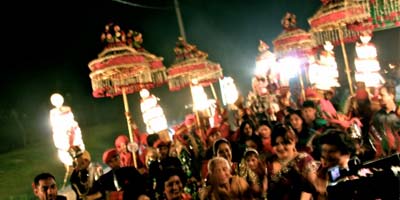Wedding Procession - Baraat (Barjaatri)
Baraat (बरात)is a Groom's Wedding procession in Indian Marriage. Weddings are joyous occasions with plenty of music, dance, partying and merry-making. Since most marriages are performed at night, the venue is filled with colourful lights, buntings and other decorative items. The marriage procession starts from the groom's house. In ancient times this ritual has been the important ritual during the Welcome of any special guest, wedding processions or Doli procession and in today's time the same has been mixed with the modern technology as the Procession uses Electric Lamps in place of Oil lamps or Mashal, It is preceded by a band which plays all the latest tunes. The bandsmen are all dressed in uniform. A number of petromax carrying men also move along with the procession.the wedding procession, 'The most lively part of the ceremonies is the wedding procession. In it the grown is taken to the bride's house. It is most colorful and beautiful sight.The, procession is led by' a brass band and dancers.

In Oriya Marriage, it is customary for the bridegroom to travel to the wedding venue (often the bride's house) in a car / mare / elephant, accompanied by his family members (except Groom's mother). The baraat in Odisha is usually a large procession, with booking its own band (dhol), DJ Music, and lights. The Baraat car is decorated in flower. The Groom do not usually take part in the dancing and singing; that is left to the "baraatis" or people accompanying the procession mainly the family and friends. The term baraati is also more generically used to describe any invitee from the groom's side. Traditionally, baraatis are attended to as guests of the bride's family.
The baraat, headed by a display of fireworks and accompanied by the rhythm of the dhol, reaches the meeting point, where the elders of both the families meet. In Oriya Hindu weddings, a traditional arti of the groom is done by either the mother-in-law or a senior female member of the family. A tilak of vermillion paste and unbroken rice is applied on the groom’s forehead. His feet are then washed with tender coconut water and he is fed a concoction of curd, ghee, sugar and honey. He is then welcomed inside along with his companions.


